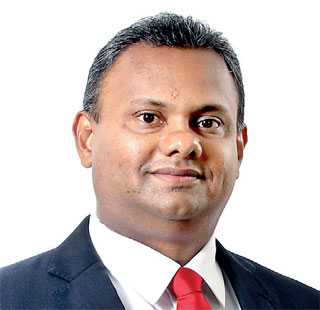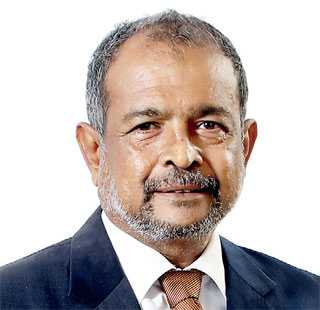Sunday Apr 20, 2025
Sunday Apr 20, 2025
Tuesday, 26 February 2019 00:15 - - {{hitsCtrl.values.hits}}
Pan Asia Banking Corporation PLC reported a solid bottom-line growth while recording a double digit growth in the loan book as the bank ploughed ahead amid the economic headwinds and the first time impact from the SLFRS 09, new accounting standard on Financial Instruments which factor Expected Credit Loss principles for loan loss provisioning.
Pan Asia Bank reported a strong 34% growth in total operating income during the financial year ended in 31 December 2018 to record Rs. 8.93 billion.
This was supported by an equally strong fund based income and non-fund based income for the period.
 |
Pan Asia Bank Chairman G.A.R.D. Prasanna |
 |
Pan Asia Bank Director/CEO Nimal Tillekeratne |
The net interest income for the year rose by a robust 39% to Rs. 6.52 billion on the back of a Rs. 19.16 billion interest income and Rs. 12.64 billion interest expense which rose by 23% and 16% respectively. Meanwhile, the bank’s net interest income for the quarter increased by an even stronger 74% to Rs. 1.8 billion over the same quarter in 2017.
The net interest income which is the difference between the revenue generated from assets and expenses tied to liabilities was driven by both loan growth and improving margins. The latter grew up to 4.37% from 3.61% in 2017 and the industry’s 3.60% for 2018.
Fund based income consist of 73% of the bank’s total operating income.
Meanwhile the non-funded income of the bank rose by 22.1% to Rs. 2.41 billion of which net fee and commission income had Rs. 1.52 billion share which itself grew by 16% during the year.
The Bank observed a substantial improvement in the other operating income in 2018 rising by 54% to Rs. 412.2 million.
The bank’s other operating income was boosted by a Rs. 377.4 million gains made on the revaluation of foreign exchange, which is up from Rs. 262.9 million recorded in the previous year.
Meanwhile, higher net forward foreign exchange gains helped the bank to increase its net trading income by 22% in 2018 to Rs. 476.4 million.
Speaking on the year-end financial results, Pan Asia Bank Director/Chief Executive Officer Nimal Tillekeratne said these numbers reflect the bank’s resilience and its ability to perform amid challenging circumstances.
“Broadly speaking, 2018 didn’t treat the banking sector well with the existence of multiple headwinds. The general deterioration in the asset quality in the sector, higher loan impairment charges resulting from the new accounting standard SLFRS 9, industry specific taxes such as debt repayment levy and the broader moderation in the demand for loans were quite conspicuous during 2018,” said Tillekeratne while commending the staff for pulling off some strong performance amid these multifaceted challenges.
The Bank reported earnings of Rs. 3.48 a share or Rs. 1.54 billion for the financial year ended in December compared to Rs. 3.31 a share or Rs. 1.39 billion in 2017. This translated in to an 11% growth in the bottom-line although much of the earnings were undermined by the higher impairment charges.
Meanwhile the bank reported earnings of Rs. 4.14 a share or Rs. 461.4 million in total profits for the most recent quarter ended in December (4Q’18) compared to Rs. 472.4 million.
The performance during the quarter was boosted by the 51% increase in the bank’s total operating income. However, the first time impact of the SLFRS 09 which led to a surge in the loan loss provisions and the impact from the newly imposed debt repayment levy undermined the bottom-line performance for a certain extent in the quarter.
SLFRS 09 impact on Credit Loss Expenses
As alluded to earlier, SLFRS 9 on Financial Instruments came in to effect for companies with reporting periods starting on or after 1 January 2018. The new financial reporting standard deals with classification and measurement of financial instruments and impairment of financial assets replacing the earlier standard, LKAS 39 – Financial Instruments: Recognition and Measurement.
The application of SLFRS 9, besides the impact from the fallout in the general asset quality in the industry, resulted in substantially higher collective impairments due to the shift in the provisioning models from the incurred credit loss method to a more forward looking expected credit loss method.
Under SLFRS 9, bank provided slightly over Rs. 2 billion as credit loss expense for the year.
The impairment charges on individually impaired customers increased the most to Rs. 1.3 billion from Rs. 337.3 as a result of the general weaknesses in the economy.
Meanwhile the collective impairment charges rose to Rs. 719.8 million from Rs. 160.2 million in 2017 partly due to the general deterioration in the portfolio quality and partly due to the shift in the provisioning method as explained above.
Business growth
Pan Asia Bank reported a double digit growth in the loans, deposits and the assets when the peer growth was languishing.
The Bank’s loans grew by 12.4% or Rs. 12.6 billion during the year with most of the growth coming during the first half. The Bank ended the year with a total loans and advances book of Rs. 113.5 billion.
The gross non-performing loans ratio rose to 5.44% by the yearend from 4.36% in December 2017. However, the bank contained the increase in the net non-performing loan ratio at 3.08%, barely unchanged from a year ago due to prudential provisioning.
Meanwhile the bank grew its deposit base by 10.7% or Rs. 11.4 billion during the year to Rs. 118.6 billion. However, the low cost current and savings account deposit base further narrowed to 16.3% due to funds shifting to high yielding term deposits, which is a natural phenomenon when the interest rates in the economy go up.
Meanwhile the total asset base of the bank grew from Rs. 138.5 billion to Rs. 154.0 billion by the yearend registering an increase of 11.0% for the year.
Operating expenses
Total operating expenses rose by 15.5% during 2018 to Rs. 4.31 billion led by the personnel expenses which in turn rose by 15.9% to Rs. 1.87 billion in 2018.
Despite the double digit increase in the total operating expenses, it remains below the growth in the total operating income for the period resulting in lower Cost-to-Income Ratio. The bank’s Cost-to-income ratio fell to 48.9% from 56.51% from 2017.
Meanwhile, the Return on Assets (RoA) another key efficiency measure stood at 1.03%, little changed from a year ago.
Capital adequacy
The Bank’s Total Common Equity Tier I Capital stood at Rs. 11.34 billion while the total capital stood at Rs. 12.77 billion by December with the two capital adequacy ratios at 11.51% and 13.32% respectively. Currently, the Bank’s capital adequacy ratios stand above the regulatory minimums of 7.875% and 11.875% by December 2018.
However, as the regulatory minimums under each rise to 8.5% and 12.5% effective from January 1,2019 with BASEL III coming in to full effect, the bank is aware that it need to ramp up its capital base in order to sustain the growth momentum towards. The Bank is in discussions with several parties to bring in the Tier II capital and remains confident that the required funds would be in place as and when needed, which will place us in a much more comfortable level in terms of capital.
Pan Asia Bank remains committed and geared to play a significant role in the Sri Lankan economy by way of helping to shape the lives and stories of many individuals and enterprises – big or small – in the years to come.
Discover Kapruka, the leading online shopping platform in Sri Lanka, where you can conveniently send Gifts and Flowers to your loved ones for any event including Valentine ’s Day. Explore a wide range of popular Shopping Categories on Kapruka, including Toys, Groceries, Electronics, Birthday Cakes, Fruits, Chocolates, Flower Bouquets, Clothing, Watches, Lingerie, Gift Sets and Jewellery. Also if you’re interested in selling with Kapruka, Partner Central by Kapruka is the best solution to start with. Moreover, through Kapruka Global Shop, you can also enjoy the convenience of purchasing products from renowned platforms like Amazon and eBay and have them delivered to Sri Lanka.
Discover Kapruka, the leading online shopping platform in Sri Lanka, where you can conveniently send Gifts and Flowers to your loved ones for any event including Valentine ’s Day. Explore a wide range of popular Shopping Categories on Kapruka, including Toys, Groceries, Electronics, Birthday Cakes, Fruits, Chocolates, Flower Bouquets, Clothing, Watches, Lingerie, Gift Sets and Jewellery. Also if you’re interested in selling with Kapruka, Partner Central by Kapruka is the best solution to start with. Moreover, through Kapruka Global Shop, you can also enjoy the convenience of purchasing products from renowned platforms like Amazon and eBay and have them delivered to Sri Lanka.